Abstract
Recent findings indicate that tandemly repeated triplet sequences in certain disease-causing human genes may render these genes highly unstable not only in meiosis but also in mitosis. Typically, a dominant mutation arises upon expansion in the number of these repeated elements. We have considered how mitotic instability of this sort might affect both phenotypic expression and allele transmission. A model based on these considerations leads to the following predictions: (i) Phenotypic severity among individuals who inherit an unstable allele should be highly variable due to stochastic variation in the stage of its earliest mutagenic expansion. (ii) Strikingly increased severity or decreased age of onset in some offspring should arise because of parental germ-line mosaicism for an expanded or mutant allele. (iii) The magnitude of genetic anticipation should be more strongly correlated with paternal than with maternal age at the time of conception. (iv) Given a child born with a severe phenotype, the recurrence risk for a second severely affected child should be significantly elevated. (v) The severity of phenotype in a child should be positively correlated with that in a parent. Available data on fragile X syndrome, Huntington disease, and myotonic dystrophy are shown to be consistent with the model, and implications for an understanding of achondroplasia and other dominant disorders are discussed.
Full text
PDF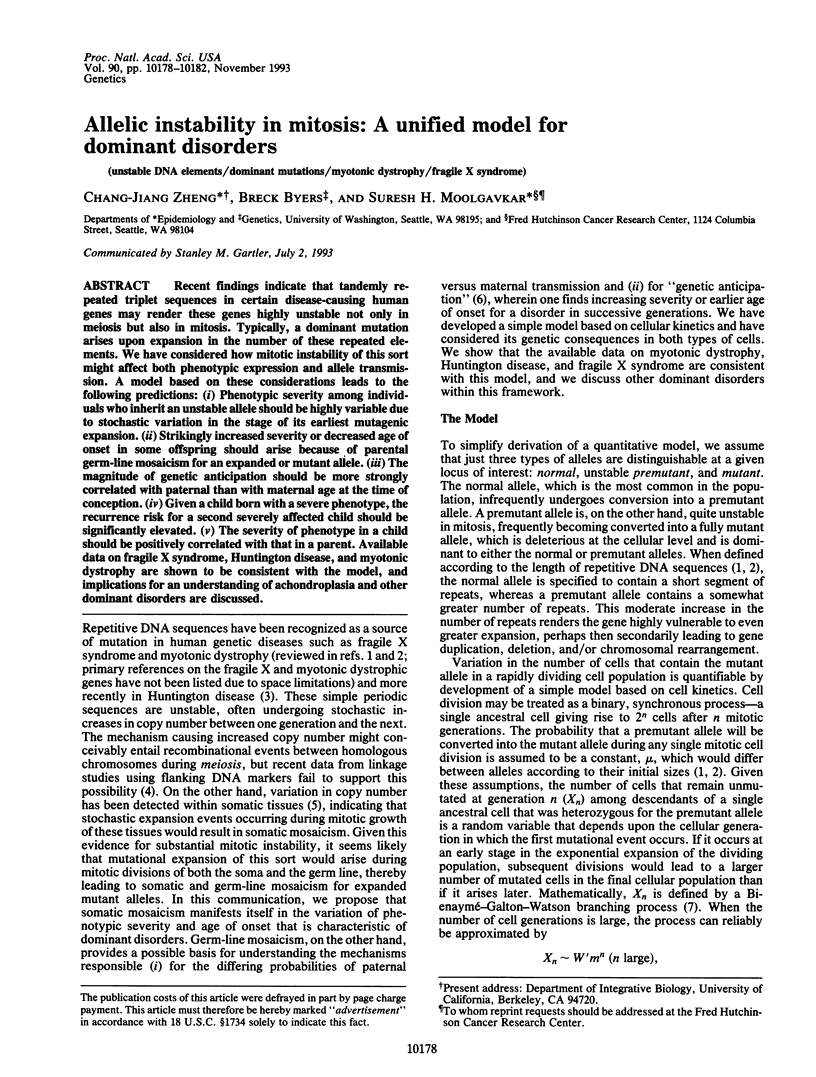
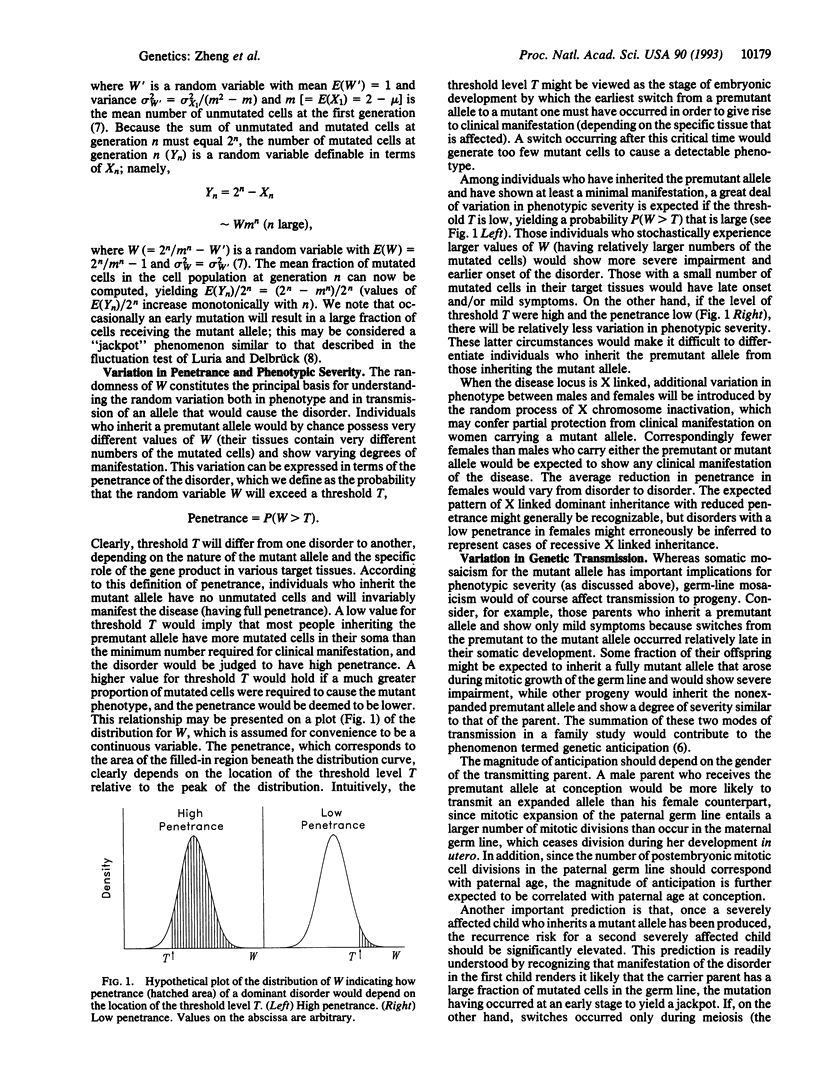
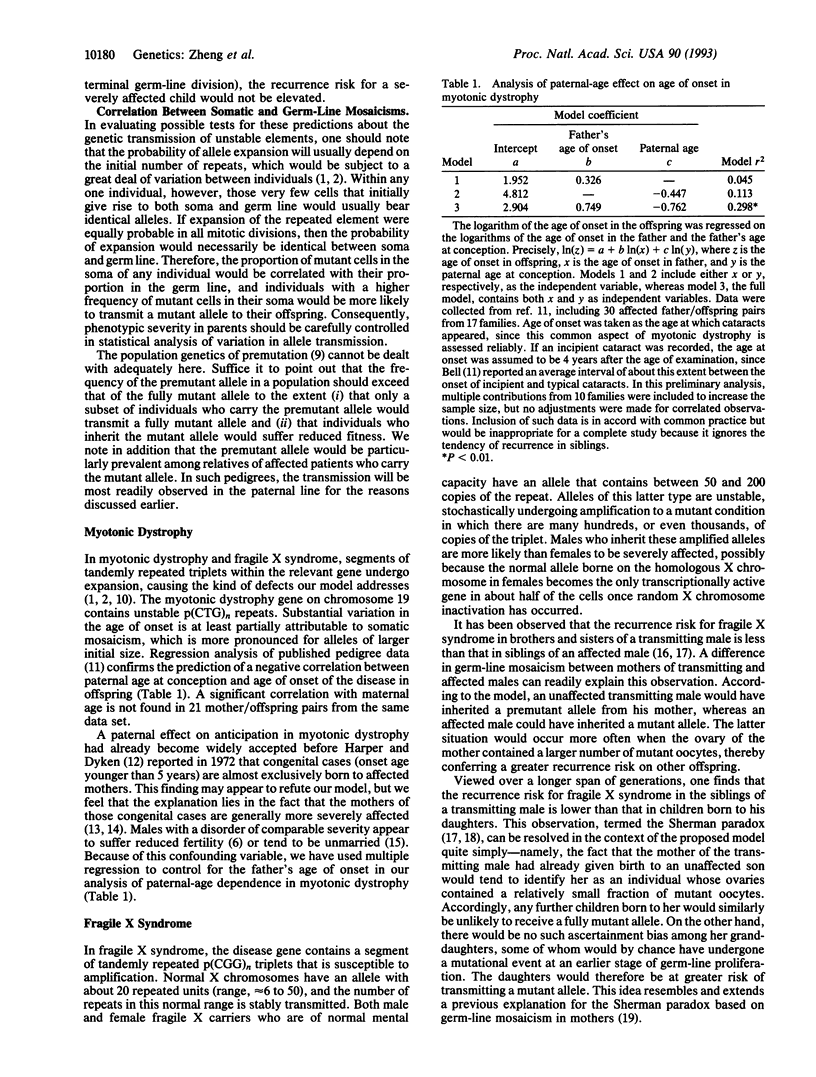
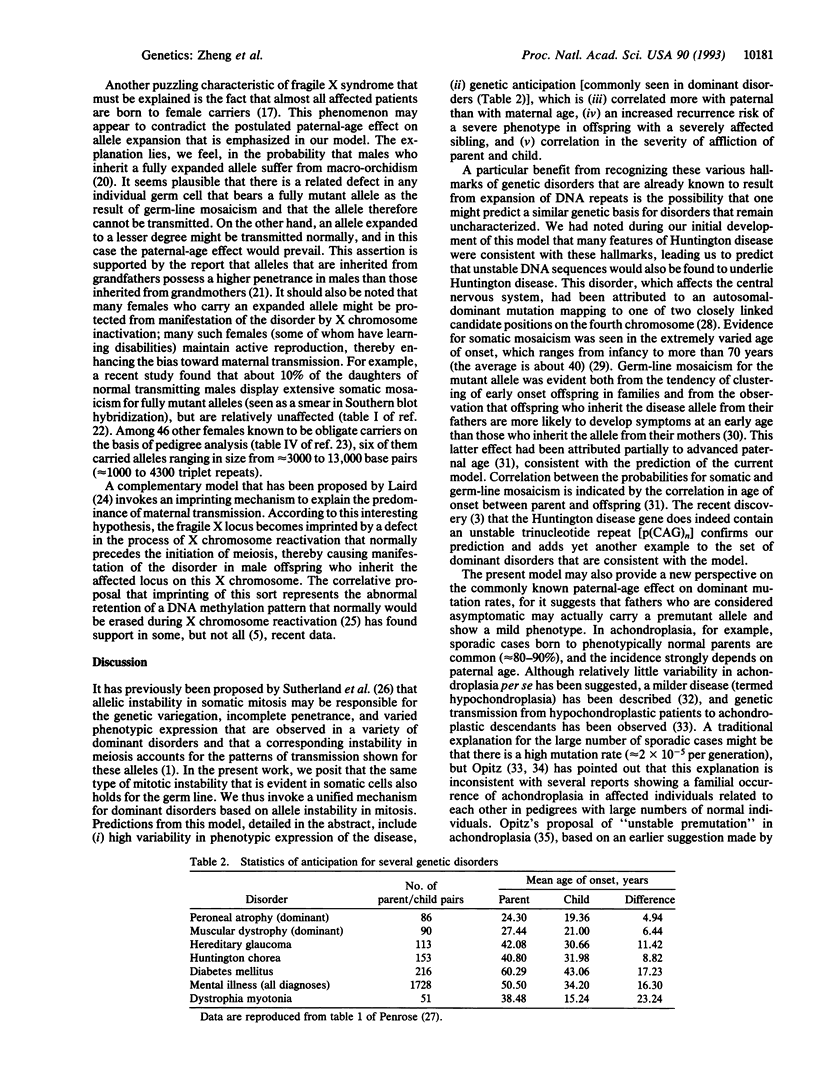
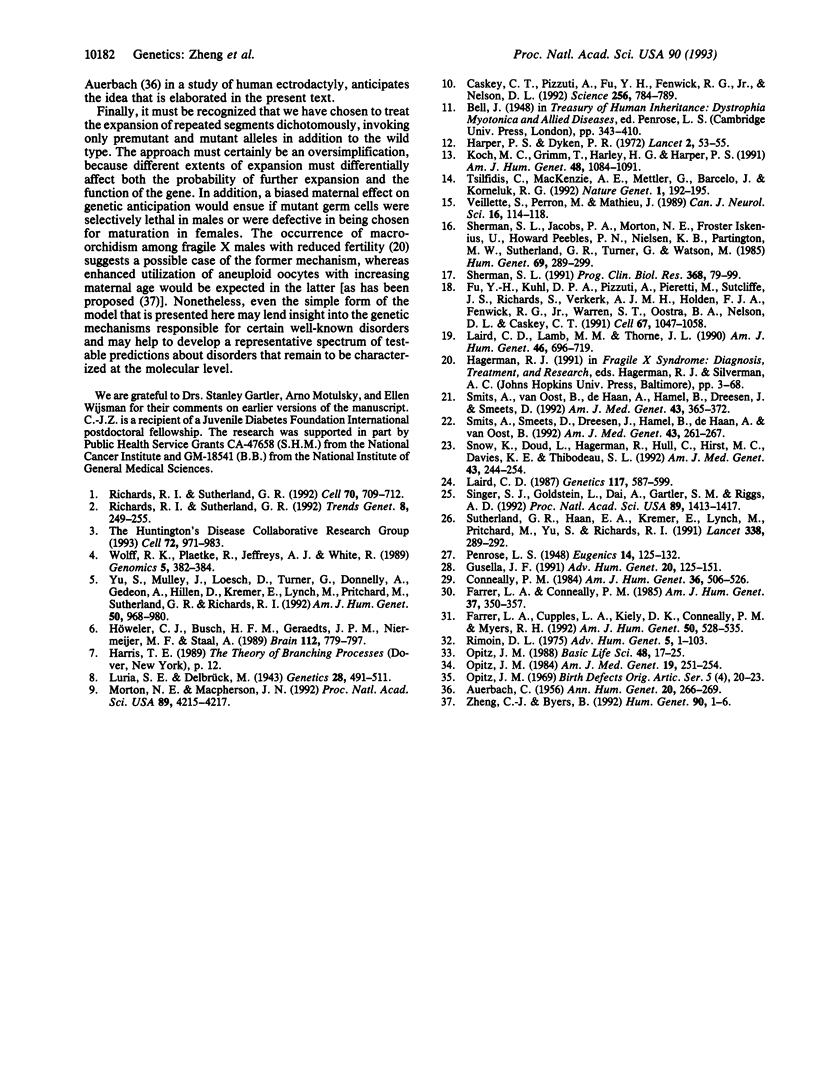
Selected References
These references are in PubMed. This may not be the complete list of references from this article.
- AUERBACH C. A possible case of delayed mutation in man. Ann Hum Genet. 1956 May;20(4):266–269. doi: 10.1111/j.1469-1809.1955.tb01281.x. [DOI] [PubMed] [Google Scholar]
- Caskey C. T., Pizzuti A., Fu Y. H., Fenwick R. G., Jr, Nelson D. L. Triplet repeat mutations in human disease. Science. 1992 May 8;256(5058):784–789. doi: 10.1126/science.1589758. [DOI] [PubMed] [Google Scholar]
- Conneally P. M. Huntington disease: genetics and epidemiology. Am J Hum Genet. 1984 May;36(3):506–526. [PMC free article] [PubMed] [Google Scholar]
- Farrer L. A., Conneally P. M. A genetic model for age at onset in Huntington disease. Am J Hum Genet. 1985 Mar;37(2):350–357. [PMC free article] [PubMed] [Google Scholar]
- Farrer L. A., Cupples L. A., Kiely D. K., Conneally P. M., Myers R. H. Inverse relationship between age at onset of Huntington disease and paternal age suggests involvement of genetic imprinting. Am J Hum Genet. 1992 Mar;50(3):528–535. [PMC free article] [PubMed] [Google Scholar]
- Fu Y. H., Kuhl D. P., Pizzuti A., Pieretti M., Sutcliffe J. S., Richards S., Verkerk A. J., Holden J. J., Fenwick R. G., Jr, Warren S. T. Variation of the CGG repeat at the fragile X site results in genetic instability: resolution of the Sherman paradox. Cell. 1991 Dec 20;67(6):1047–1058. doi: 10.1016/0092-8674(91)90283-5. [DOI] [PubMed] [Google Scholar]
- Gusella J. F. Huntington's disease. Adv Hum Genet. 1991;20:125–151. [PubMed] [Google Scholar]
- Harper P. S., Dyken P. R. Early-onset dystrophia myotonica. Evidence supporting a maternal environmental factor. Lancet. 1972 Jul 8;2(7767):53–55. doi: 10.1016/s0140-6736(72)91548-6. [DOI] [PubMed] [Google Scholar]
- Höweler C. J., Busch H. F., Geraedts J. P., Niermeijer M. F., Staal A. Anticipation in myotonic dystrophy: fact or fiction? Brain. 1989 Jun;112(Pt 3):779–797. doi: 10.1093/brain/112.3.779. [DOI] [PubMed] [Google Scholar]
- Koch M. C., Grimm T., Harley H. G., Harper P. S. Genetic risks for children of women with myotonic dystrophy. Am J Hum Genet. 1991 Jun;48(6):1084–1091. [PMC free article] [PubMed] [Google Scholar]
- Laird C. D., Lamb M. M., Thorne J. L. Two progenitor cells for human oogonia inferred from pedigree data and the X-inactivation imprinting model of the fragile-X syndrome. Am J Hum Genet. 1990 Apr;46(4):696–719. [PMC free article] [PubMed] [Google Scholar]
- Laird C. D. Proposed mechanism of inheritance and expression of the human fragile-X syndrome of mental retardation. Genetics. 1987 Nov;117(3):587–599. doi: 10.1093/genetics/117.3.587. [DOI] [PMC free article] [PubMed] [Google Scholar]
- Luria S. E., Delbrück M. Mutations of Bacteria from Virus Sensitivity to Virus Resistance. Genetics. 1943 Nov;28(6):491–511. doi: 10.1093/genetics/28.6.491. [DOI] [PMC free article] [PubMed] [Google Scholar]
- Morton N. E., Macpherson J. N. Population genetics of the fragile-X syndrome: multiallelic model for the FMR1 locus. Proc Natl Acad Sci U S A. 1992 May 1;89(9):4215–4217. doi: 10.1073/pnas.89.9.4215. [DOI] [PMC free article] [PubMed] [Google Scholar]
- Opitz J. M. "Unstable premutation" in achondroplasia: penetrance vs phenotrance. Am J Med Genet. 1984 Oct;19(2):251–254. doi: 10.1002/ajmg.1320190207. [DOI] [PubMed] [Google Scholar]
- Opitz J. M. Premutation in achondroplasia. Basic Life Sci. 1988;48:17–25. doi: 10.1007/978-1-4684-8712-1_3. [DOI] [PubMed] [Google Scholar]
- Richards R. I., Sutherland G. R. Dynamic mutations: a new class of mutations causing human disease. Cell. 1992 Sep 4;70(5):709–712. doi: 10.1016/0092-8674(92)90302-s. [DOI] [PubMed] [Google Scholar]
- Rimoin D. L. The chondrodystrophies. Adv Hum Genet. 1975;5:1–118. doi: 10.1007/978-1-4615-9068-2_1. [DOI] [PubMed] [Google Scholar]
- Sherman S. L. Genetic epidemiology of the fragile X syndrome with special reference to genetic counseling. Prog Clin Biol Res. 1991;368:79–99. [PubMed] [Google Scholar]
- Sherman S. L., Jacobs P. A., Morton N. E., Froster-Iskenius U., Howard-Peebles P. N., Nielsen K. B., Partington M. W., Sutherland G. R., Turner G., Watson M. Further segregation analysis of the fragile X syndrome with special reference to transmitting males. Hum Genet. 1985;69(4):289–299. doi: 10.1007/BF00291644. [DOI] [PubMed] [Google Scholar]
- Singer-Sam J., Goldstein L., Dai A., Gartler S. M., Riggs A. D. A potentially critical Hpa II site of the X chromosome-linked PGK1 gene is unmethylated prior to the onset of meiosis of human oogenic cells. Proc Natl Acad Sci U S A. 1992 Feb 15;89(4):1413–1417. doi: 10.1073/pnas.89.4.1413. [DOI] [PMC free article] [PubMed] [Google Scholar]
- Smits A. P., van Oost B. A., de Haan A. F., Hamel B. C., Dreesen J. C., Smeets D. F. Penetrance of fra(X) gene: influence of grandparental origin of the gene, mental status of the carrier mother, and presence of a normal transmitting male. 1992 Apr 15-May 1Am J Med Genet. 43(1-2):365–372. doi: 10.1002/ajmg.1320430157. [DOI] [PubMed] [Google Scholar]
- Smits A., Smeets D., Dreesen J., Hamel B., de Haan A., van Oost B. Parental origin of the fra(X) gene is a major determinant of the cytogenetic expression and the CGG repeat length in female carriers. 1992 Apr 15-May 1Am J Med Genet. 43(1-2):261–267. doi: 10.1002/ajmg.1320430141. [DOI] [PubMed] [Google Scholar]
- Snow K., Doud L., Hagerman R., Hull C., Hirst M. C., Davies K. E., Thibodeau S. L. Analysis of mutations at the fragile X locus using the DNA probe Ox1.9. 1992 Apr 15-May 1Am J Med Genet. 43(1-2):244–254. doi: 10.1002/ajmg.1320430139. [DOI] [PubMed] [Google Scholar]
- Sutherland G. R., Haan E. A., Kremer E., Lynch M., Pritchard M., Yu S., Richards R. I. Hereditary unstable DNA: a new explanation for some old genetic questions? Lancet. 1991 Aug 3;338(8762):289–292. doi: 10.1016/0140-6736(91)90426-p. [DOI] [PubMed] [Google Scholar]
- Tsilfidis C., MacKenzie A. E., Mettler G., Barceló J., Korneluk R. G. Correlation between CTG trinucleotide repeat length and frequency of severe congenital myotonic dystrophy. Nat Genet. 1992 Jun;1(3):192–195. doi: 10.1038/ng0692-192. [DOI] [PubMed] [Google Scholar]
- Veillette S., Perron M., Mathieu J. La dystrophie myotonique: II. Nuptialité, fécondité et transmission. Can J Neurol Sci. 1989 Feb;16(1):114–118. [PubMed] [Google Scholar]
- Wolff R. K., Plaetke R., Jeffreys A. J., White R. Unequal crossingover between homologous chromosomes is not the major mechanism involved in the generation of new alleles at VNTR loci. Genomics. 1989 Aug;5(2):382–384. doi: 10.1016/0888-7543(89)90076-1. [DOI] [PubMed] [Google Scholar]
- Yu S., Mulley J., Loesch D., Turner G., Donnelly A., Gedeon A., Hillen D., Kremer E., Lynch M., Pritchard M. Fragile-X syndrome: unique genetics of the heritable unstable element. Am J Hum Genet. 1992 May;50(5):968–980. [PMC free article] [PubMed] [Google Scholar]
- Zheng C. J., Byers B. Oocyte selection: a new model for the maternal-age dependence of Down syndrome. Hum Genet. 1992 Sep-Oct;90(1-2):1–6. doi: 10.1007/BF00210736. [DOI] [PubMed] [Google Scholar]


